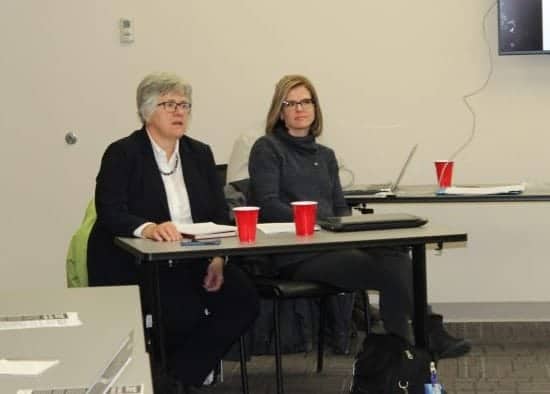To live a “decent and dignified” life in Yellowknife, each adult in a family of four with two young children must earn $22.24 per hour, says Alternatives North.

Yellowknife Centre MLA Julie Green and Grand Prairie-based economist Michel Haerner speak at a luncheon Monday about Yellowknife's living wage, which rose to $22.24 in 2017.
Nov. 27, 2017
The social justice organization has released an updated the “living wage” for a representative family in the city. The amount is what each adult, working full-time, must earn in order to relieve some of the stress of making ends meet.
According to the organization's calculation, which is based on the Canadian Living Wage Framework, Yellowknife's living wage amounts to about $46,000 a year per adult in a double-income family.
The living wage calculation is based on the costs of living for a family with two adults, one child in childcare and another in elementary school. A couple with children is the most common household structure in the Northwest Territories, according to NWT Bureau of Statistics.
The idea underpinning the living wage is that no one who works 40 hours a week should be living in poverty.
And yet, says Alternatives North, this is the case for many Yellowknife residents.
Yellowknife Centre MLA Julie Green said she hopes the living wage model drives home to territorial and municipal governments that Yellowknife is “clearly a very expensive place to live.”
“I want them to consider that we need things like a better rent subsidy program, we need a better childcare subsidy program, we need some attention paid to how to make food more affordable,” she said.
Green, who spoke at a luncheon Monday promoting the living wage, and is named as an Alternatives North spokesperson in a Nov. 21 news release from the organization, said she was not at the event in her capacity as an MLA. She told the small crowd that she was not using legislative assembly resources for the lunch, nor was she paid by Alternatives North to be there.
Green believes the high cost of living in Yellowknife is driving families away.
“They feel that their money goes further in a southern location, so they go,” she said.
A living wage is not to be confused with the minimum wage, which is lowest amount employers can legally pay their workers.
In Yellowknife, the minimum wage is $12.50 per hour.
2016 Statistics Canada data indicates about 4,400 people in Yellowknife earned less than $40,000 in employment income.
Michel Haener, a Yellowknife-raised and Grand Prairie, Alta.-based economist, calculated the living wage for Yellowknife and other communities.
She said Monday that she uses information from Statistics Canada, the Canadian Mortgage and Housing Corporation, and others to come up with the figure.
The living wage accounts for a no-frills budget that includes food, rental housing, transportation, daycare, health care, adult education, basic household expenses and a small emergency fund.
Also factored in are taxes and income from government transfers, such as the Canada Child Benefit.
The living wage does not afford money for pets, credit card or loan payments, hobbies, alcohol or tobacco, savings for retirement, or the costs of caring for an ill or elderly loved one. It also doesn't account for any financial help offered by from family members.
The 2017 living wage for Yellowknife rose $1.56 per person per hour from two years ago, when it was pegged at $20.68.
Haener said that Yellowknife's living wage has risen more sharply than that of other communities.
She said this is primarily due to the higher costs of perishable food, housing and childcare.
Indeed, Yellowknife commands one of the highest living wages in Canada.
The living wage in Whitehorse, for example, is $18.26. In Vancouver, where housing is notoriously pricey, the living wage is set at $20.62.
Haener said that families in Yellowknife may find federal tax credits, such as those meant to help out parents, don't have the same impact in Yellowknife as they would for families in the south.
Everyday expenses, such as the cost of fresh vegetables and rent, are greater in Yellowknife, and call for higher incomes to meet those basic needs.
But national programs, such as the Canada Child Benefit, use set, net household income thresholds to determine how much money each family will get.
The result is that many Yellowknife families are “in that zone where (the Canada Child Benefit) is mostly clawed back compared to some other families,” said Haener, despite the fact that Yellowknife families must spend more of their income on basic necessities.
Deneen Everett, executive director of the Yellowknife Chamber of Commerce, said the living wage highlights just how expensive it is to live in the north.
Everett said paying $22.24 an hour isn't an option for most sole-proprietors, start-ups and small restaurant and shop-owners.
“Businesses have to get creative in how they provide benefits to their employees, whether that be incentives for days off or flexibility in their work schedules,” she said.
The chamber does not take an official position on the living wage.
“Our role is not to tell businesses how to do business,” said Everett.
Alternatives North published six recommendations for actions that can help families on low incomes meet their needs.
These include the creation of a Yellowknife food strategy, expanding the NWT Housing Corporation's transitional rent supplement program, and increasing the income cutoff for the government of Northwest Territories' child benefit program to $90,000 a year.
The group recommends businesses pay living wages to all their employees. It says higher wages will cut turnover and the costs of hiring and training new workers.
Alternatives North also recommends the GNWT and federal government work together to increase access to free tax preparation services so that Yellowknife residents can take full advantage of the benefits available to them.